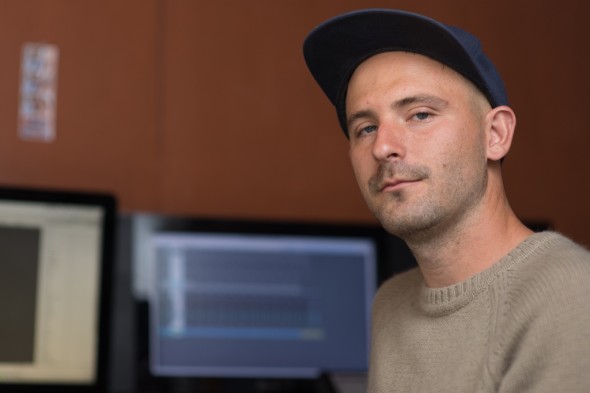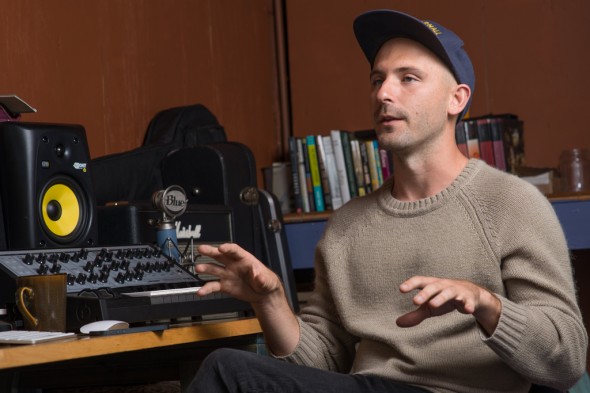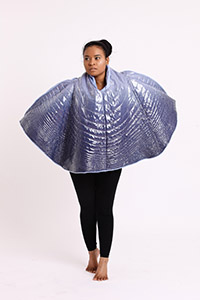
San Diego may not exactly be known as a hotspot for film composers, but at least one guy is working to change that. Erik Jourgensen set up shop in our fair city a year ago, and since then he’s composed music for movies, video games, fashion events, and various other multimedia projects.
The 26-year-old is currently at work on Callejero, the new film from director Ray Gallardo about an exiled Mexican boxer trying to reconnect with his estranged family. The film will be submitted for festival consideration later this year. We stopped by Jourgensen’s University Heights studio to talk about Callejero, how to compose music for different media, and what a good soundtrack should accomplish.
Owl and Bear: How did you get involved with Callejero?
Erik Jourgensen: I actually found the director [Ray Gallardo] on Craigslist. He made a Craigslist ad looking for a composer and I responded to it, probably almost a year ago. For the first month or two after he posted I didn’t hear anything back from him. I applied to stuff all over the internet all the time — I find filmmakers that are posting jobs on various sites.
So he didn’t get back to me and then maybe two or three months later, around September or October, he said he liked my music and wanted to meet up. So we got coffee and talked about the film. And then he had me do a test scene for it. He just gave me a sample scene and said, “Do what you want with it.” So I did that and sent it back to him, he sent it to his producers, and he ended up liking it so we moved forward.
Owl and Bear: Your other musical projects tend to lean toward more electronic sounds. What challenges did composing the comparatively organic score to Callejero present?
Erik Jourgensen: Well I really got into music at first by taking guitar lessons, and I really wanted to record music. That was around the time that GarageBand came out, so I got a little white MacBook and it had GarageBand on it. So pretty much immediately, once I was learning how to play music, I was recording it. At first all I listened to was blues music like Elmore James and was trying to make my own versions of those types of songs. I was playing slide guitar and electric guitar, just recording that and chopping things up. Then I would get into different genres as I was learning about music from being a teenager. I was in high school and learned about Aphex Twin or Wu-Tang Clan, and I would try to emulate whatever they were doing. By the time I was doing more electronic stuff I was kind of cementing my own style, but I’ve always experimented with whatever instruments I can. I use guitar sometimes or banjo or sitar.
I was excited about Callejero because he said, “Do what you want and what you think is appropriate. Come up with what you think is going to serve the film the best.” And so after I watched it, I thought a lot about how there’s a very strong nationalistic element to it, so I wanted there to be more traditional Mexican sounds. But there’s also this gangster element to it, so I wanted that to have a very cold, brooding sound, so I used the synthesizer. I just thought, “What’s going to serve the project best?” I played around with different instruments to different scenes to get the right mood and built the sound palette that way.
Owl and Bear: At what stage in the film’s production progress did you decide on what would become the main musical themes?
Erik Jourgensen: Well the way it worked was that he has already been working on the movie for a year or two. It’s his first feature film — he’s done shorts up until this. So he basically sent me the first third of the film, then the second third of the film, and then the final part of it, and I went to the scenes that I thought would best be served by music. I focused on those the most at first, and I developed some themes off of those. Some parts just needed a little bit of guitar to add the right mood. A lot of the gangster scenes, all I have is just the Moog synth droning underneath it. It was kind of like developing the sound palette, then sticking to what was most important and building off of that.

Owl and Bear: Callejero takes place in Tijuana and along the Mexican border. How much research into Mexican music did you have to do to infuse your score with a local flavor?
Erik Jourgensen: I’d taken an American Music class in college, and a lot of music along the border is influenced by Mexican music and American pop. So I was trying to be modern but also do my own take on it. I listened to some of those artists and went back and tried to do my own flavor of it. And luckily, I had a friend who came in who was trained in Mexico in classical guitar. He would come in and say, “I don’t know, that’s not quite the right sound,” and he helped me shape it a little bit.
Owl and Bear: To make it sound more authentic?
Erik Jourgensen: Yeah, he played some guitar for me, and I took parts of his guitar and interspersed it throughout the score just so it had the right flavor.
Owl and Bear: How does composing for a movie differ from composing for a video game?
Erik Jourgensen: It’s still about emotion, but games involve a lot of looping, so you have to focus on, “How can I make a one-minute composition that can be looped a thousand times and won’t sound too annoying?” If there’s a melody going on in a high frequency range, it’s not going to do justice to the player because it’s going to be kind of annoying. Same with drums. You have to be aware of the medium and how people are going to play the game. Especially because I’ve worked on cell phone games, so if there are highs or booming lows it’s just going to sound terrible. I think about the medium and who the audience is, and it’s based on that mostly.
Owl and Bear: You composed music for San Diego Fashion Week last year. What type of direction do they give you in terms of what they want the finished product to sound like?
Erik Jourgensen: That was really fun. What I did was, I contacted the designers I liked the most that were presenting there and a few of them got back to me. I looked at their line, I talked to them on the phone, and we talked about their musical influences. So I just went off of that and gave them initial demos, and they said, “Tweak this a little bit,” or “This is good.” All of them were pretty happy with it — it was a fairly painless process.
Owl and Bear: Did they ever tell you they wanted something with a certain type of feel or conveyed a certain type of emotion, or did they leave that up to you?

Erik Jourgensen: One of them was Maegan of Maegan Stracy Design, and she’s from somewhere in the Midwest. Her clothes are very modern and use very unconventional materials. She comes from a very artistic background. She said Aphex Twin was an influence, or maybe I just took that from what I saw. So I knew it had to have a pretty strong beat for the models to walk to, but I didn’t want to make some sort of EDM club beat. [Laughs.] Especially for clothes like that, because that just wouldn’t do it justice. I looked at her clothes and messed around with different styles. One of them was this weird disco jam with a Rhodes piano and a driving beat and snare, but that still wasn’t crazy enough for it. So I went back and made a few other pieces and stitched them together, and I sent it to her and she thought it was great.
The other designer was from Bali, so she wanted it to be very Bali-influenced but also modern and have radio music interwoven in there. So with that, I typed “Balinese music” in YouTube and listened to some it. I sampled a little snippet of somebody and put it in there, messed with the sample, and built something off that. It was really fun and I hope I can do more of it. I would love to do as many fashion shows as I can.
Owl and Bear: Your website says that you seek out projects that challenge you to rethink the purpose of music in visual media. What is that purpose?
Erik Jourgensen: Most of the time it’s just serving emotion and aesthetic. It really depends on the project — I set out to do a particular style. I have the most fun making music when I’m uncomfortable. Sometimes, what I’ll do is set up a microphone and sing random things into it and make a composition out of that. So for me, every project is going to be different from what I’ve worked on before. That’s what’s inspiring: I’m always trying to push myself to feel a bit uncomfortable working in genres that I haven’t before, or combining genres that I haven’t heard combined before. I’m not a master at any instrument — I’m not particularly amazing at the keyboard or guitar or singing — but I think if I take what I do know and mix it together it can be interesting. I try to find the emotional aesthetic of a project, get into it that way, and add something to it by doing that.
